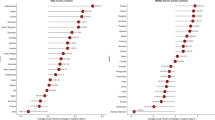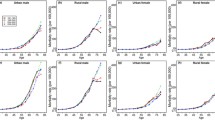Abstract
Objective
We examined subsite- and histology-specific esophageal and gastric cancer incidence patterns among Hispanics/Latinos and compared them with non-Hispanic whites and non-Hispanic blacks.
Methods
Data on newly diagnosed esophageal and gastric cancers for 1998–2002 were obtained from 37 population-based central cancer registries, representing 66% of the Hispanic population in the United States. Age-adjusted incidence rates (2000 US) were computed by race/ethnicity, sex, anatomic subsite, and histology. The differences in incidence rates between Hispanics and non-Hispanics were examined using the two-tailed z-statistic.
Results
Squamous cell carcinoma accounted for 50% and 57% of esophageal cancers among Hispanic men and women, respectively, while adenocarcinoma accounted for 43% among Hispanic men and 35% among Hispanic women. The incidence rate of squamous cell carcinoma was 48% higher among Hispanic men (2.94 per 100,000) than non-Hispanic white men (1.99 per 100,000) but about 70% lower among Hispanics than non-Hispanic blacks, for both men and women. In contrast, the incidence rates of esophageal adenocarcinoma were lower among Hispanics than non-Hispanic whites (58% lower for men and 33% for women) but higher than non-Hispanic blacks (70% higher for men and 64% for women). Cardia adenocarcinoma accounted for 10–15% of gastric cancers among Hispanics, and the incidence rate among Hispanic men (2.42 per 100,000) was 33% lower than the rate of non-Hispanic white men (3.62 per 100,000) but 37% higher than that of non-Hispanic black men. The rate among Hispanic women (0.86 per 100,000), however, was 20% higher than that of non-Hispanic white women (0.72 per 100,000) and 51% higher than for non-Hispanic black women. Gastric non-cardia cancer accounted for approximately 50% of gastric cancers among Hispanics (8.32 per 100,000 for men and 4.90 per 100,000 for women), and the rates were almost two times higher than for non-Hispanic whites (2.95 per 100,000 for men and 1.72 per 100,000 for women) but about the same as the non-Hispanic blacks.
Conclusion
Subsite- and histology-specific incidence rates of esophageal and gastric cancers among Hispanics/Latinos differ from non-Hispanics. The incidence rates of gastric non-cardia cancer are almost two times higher among Hispanics than non-Hispanic whites, both men and women. The rates of gastric cardia cancer are lower among Hispanics than non-Hispanic whites for men but higher for women. The rates of esophageal and gastric cardia adenocarcinomas are higher among Hispanics than non-Hispanic blacks.
Similar content being viewed by others
References
Howe H, Wu X, Ries L, Cokkinides V, Ahmed F, Jemal A, Miller B, Williams M, Ward E, Wingo P, Ramirez A, Edwards B (2006) Annual report to the nation on the status of cancer, 1975–2003, featuring cancer among U.S. Hispanic/Latino populations. Cancer 107(8):1711–1742
O’Brien K, Cokkinides V, Jemal A, Cardinez C, Murray T, Samuels A, Ward E, Thun M (2003) Cancer statistics for Hispanics, 2003. CA Cancer J Clin 53(4):208–226
El-Serag H, Mason A, Petersen N, Key C (2002) Epidemiological differences between adenocarcinoma of the oesophagus and adenocarcinoma of the gastric cardia in the USA. Gut 50(3):368–372
Zhang Z, Kurtz R, Sun M, Karpeh MJ, Yu G, Gargon N, Fein J, Georgopoulos S, Harlap S (1996) Adenocarcinomas of the esophagus and gastric cardia: medical conditions, tobacco, alcohol, and socioeconomic factors. Cancer Epidemiol Biomarkers Prev 5(10):761–768
Brown L (2000) The role of race/ethnicity in the epidemiology of esophageal cancer. J Assoc Acad Minor Phys 11(2–3):32–37
Chang J, Katzka D (2004) Gastroesophageal reflux disease, Barrett esophagus, and esophageal adenocarcinoma. Arch Intern Med 164(14):1482–1488
Engel L, Chow W, Vaughan T, Gammon M, Risch H, Stanford J (2003) Population attributable risks of esophageal and gastric cancers. JNCI 95(18):1404–1413
Kubo A, Corley D (2004) Marked multi-ethnic variation of esophageal and gastric cardia carcinomas within the United States. Am J Gastroenterol 99(4):582–588
Ellison J, Wu X, Howe H, McLaughlin C, Lake A, Firth R, Sullivan S, Roney D, Cormier M, Leonfellner S, Kosary C (eds) (2005) Cancer in North America. Vol. Volume Three. North American Association of Central Cancer Registries, Springfield
Trapido E, Burciaga-Valdez R, Obeso J, Strickman-Stein N, Rotger A, Perez-Stable E (1995) Epidemiology of cancer among Hispanics in the United States. J Natl Cancer Inst Monogr 18:17–28
Stewart S, Swallen K, Glaser S, Horn-Ross P, West D (1999) Comparison of methods for classifying Hispanic ethnicity in a population-based cancer registry. Am J Epidemiol 149(11):1063–1071
NAACCR (2003) Report of the NAACCR expert panel on Hispanic identification. North American Association of Central Cancer Registries, Springfield
Fritz A, Percy C, Jack A, Shanmugaratnam K, Sobin L, Parkin D, Whelan S (eds) (2000) International classification of diseases for oncology, 3rd edn. World Health Organization, Geneva
Esteve J, Benhamou E, Raymond L (1994) Statistical methods in cancer research. Descriptive epidemiology, vol IV. International Agency for Research on Cancer, France
Gammon M, Schoenberg J, Ahsan H, Risch H, Vaughan T, Chow W, Rotterdam H, West A, Dubrow R, Stanford J, Mayne S, Farrow D, Niwa S, Blot W, Fraumeni JJ (1997) Tobacco, alcohol, and socioeconomic status and adenocarcinomas of the esophagus and gastric cardia. J Natl Cancer Inst 89(17):1277–1284
Garidou A, Tzonou A, Lipworth L, Signorello L, Kalapothaki V, Trichopoulos D (1996) Life-style factors and medical conditions in relation to esophageal cancer by histologic type in a low-risk population. Int J Cancer 68(3):295–299
Thompson F, Midthune D, Subar A, McNeel T, Berrigan D, Kipnis V (2005) Dietary intake estimates in the National Health Interview Survey, 2000: methodology, results, and interpretation. J Am Diet Assoc 105(3):352–363
Lagergren J, Bergstrom R, Lindgren A, Nyren O (2000) The role of tobacco, snuff and alcohol use in the aetiology of cancer of the oesophagus and gastric cardia. Int J Cancer 85(3):340–346
Brown L, Silverman D, Pottern L, Schoenberg J, Greenberg R, Swanson G, Liff J, Schwartz A, Hayes R, Blot W (1994) Adenocarcinoma of the esophagus and esophagogastric junction in white men in the United States: alcohol, tobacco, and socioeconomic factors. Cancer Causes Control 5(4):333–340
Nyren O, Adami HO (2002) Esophageal cancer. In: Adami HO, Hunter D, Trivchopoulos D (eds) Text book of cancer epidemiology. Oxford University Press, London
Lagergren J, Bergstrom R, Nyren O (1999) Association between body mass and adenocarcinoma of the esophagus and gastric cardia. Ann Intern Med 130(11):883–890
Brown L, Swanson C, Gridley G, Swanson G, Schoenberg J, Greenberg R, Silverman D, Pottern L, Hayes R, Schwartz A (1995) Adenocarcinoma of the esophagus: role of obesity and diet. J Natl Cancer Inst 87(2):104–109
Chow WH, Blot WJ, Vaughan TL, Risch HA, Gammon MD, Stanford JL, Dubrow R, Schoenberg JB, Mayne ST, Farrow DC, Ahsan H, West AB, Rotterdam H, Niwa S, Fraumeni JFJ (1998) Body mass index and risk of adenocarcinomas of the esophagus and gastric cardia. JNCI 90(2):150–155
Lagergren J, Bergstrom R, Lindgren A, Nyren O (1999) Symptomatic gastroesophageal reflux as a risk factor for esophageal adenocarcinoma. N Engl J Med 340(11):825–831
Shaheen N, Ransohoff D (2002) Gastroesophageal reflux, barrett esophagus, and esophageal cancer: scientific review. JAMA 287(15):1972–1981
Mayne S, Navarro S (2002) Diet, obesity and reflux in the etiology of adenocarcinomas of the esophagus and gastric cardia in humans. J Nutr 132(11 Suppl):3467S–3470S
Bersentes K, Fass R, Padda S, Johnson C, Sampliner R (1998) Prevalence of Barrett’s esophagus in Hispanics is similar to Caucasians. Dig Dis Sci 43(5):1038–1041
Denney J, Krueger P, Rogers R, Boardman J (2004) Race/ethnic and sex differentials in body mass among US adults. Ethn Dis 14(3):389–398
Ward E, Jemal A, Cokkinides V, Singh G, Cardinez C, Ghafoor A, Thun M (2004) Cancer disparities by race/ethnicity and socioeconomic status. CA Cancer J Clin 54(2):78–93
Wijnhoven B, Siersema P, Hop W, van Dekken H, Tilanus H (1999) Adenocarcinomas of the distal oesophagus and gastric cardia are one clinical entity. Rotterdam Oesophageal Tumour Study Group. Br J Surg 86(4):529–535
Nguyen A, Luke C, Roder D (2003) Comparative epidemiological characteristics of oesophageal adenocarcinoma and other cancers of the oesophagus and gastric cardia. Asian Pac J Cancer Prev 4(3):225–231
Ekstrom A, Hansson L, Signorello L, Lindgren A, Bergstrom R, Nyren O (2000) Decreasing incidence of both major histologic subtypes of gastric adenocarcinoma – a population-based study in Sweden. Br J Cancer 83(3):391–396
Hansson L, Engstrand L, Nyren O, Evans DJ, Lindgren A, Bergstrom R, Andersson B, Athlin L, Bendtsen O, Tracz P (1993) Helicobacter pylori infection: independent risk indicator of gastric adenocarcinoma. Gastroenterology 105(4):1098–1103
Sasazuki S, Sasaki S, Tsugane S (2002) Cigarette smoking, alcohol consumption and subsequent gastric cancer risk by subsite and histologic type. Int J Cancer 101(6):560–566
Brenner H, Arndt V, Stegmaier C, Ziegler H, Rothenbacher D (2004) Is Helicobacter pylori infection a necessary condition for noncardia gastric cancer? Am J Epidemiol 159(3):252–258
Nomura A, Hankin J, Kolonel L, Wilkens L, Goodman M, Stemmermann G (2003) Case–control study of diet and other risk factors for gastric cancer in Hawaii (United States). Cancer Causes Control 14(6):547–558
Dhillon P, Farrow D, Vaughan T, Chow W, Risch H, Gammon M, Mayne S, Stanford J, Schoenberg J, Ahsan H, Dubrow R, West A, Rotterdam H, Blot W, Fraumeni JJ (2001) Family history of cancer and risk of esophageal and gastric cancers in the United States. Int J Cancer 93(1):148–152
Talley N, Zinsmeister A, Weaver A, DiMagno E, Carpenter H, Perez-Perez G, Blaser M (1991) Gastric adenocarcinoma and Helicobacter pylori infection. JNCI 83(23):1734–1739
Anonymous (1993) An international association between Helicobacter pylori infection and gastric cancer. The EUROGAST Study Group. Lancet 341(8857):1359–1362
Brown L (2000) Helicobacter pylori: epidemiology and routes of transmission. Epidemiol Rev 22(2):283–297
Banatvala N, Mayo K, Megraud F, Jennings R, Deeks J, Feldman R (1993) The cohort effect and Helicobacter pylori. J Infect Dis 168(1):219–221
Correa P (2003) Helicobacter pylori infection and gastric cancer. Cancer Epidemiol Biomarkers Prev 12(3):238s–241s
Bureau UC (2000) Poverty status in 1999 by sex and age. In: 4 CSF, ed
Bureau UC (2000) Sex by year of entry for the foreign-born. In: 4 CSF, ed
McQuillan G, Kruszon-Moran D, Kottiri B, Curtin L, Lucas J, Kington R (2005) Racial and ethnic differences in the seroprevalence of 6 infectious diseases in the United States: data from NHANES III, 1988–1994. Am J Public Health 94(11):1952–1958
Author information
Authors and Affiliations
Corresponding author
Rights and permissions
About this article
Cite this article
Wu, X., Chen, V.W., Andrews, P.A. et al. Incidence of esophageal and gastric cancers among Hispanics, non-Hispanic whites and non-Hispanic blacks in the United States: subsite and histology differences. Cancer Causes Control 18, 585–593 (2007). https://doi.org/10.1007/s10552-007-9000-1
Received:
Accepted:
Published:
Issue Date:
DOI: https://doi.org/10.1007/s10552-007-9000-1




